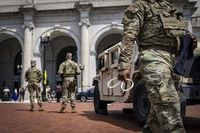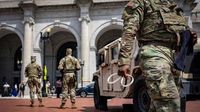On a sweltering August afternoon in 2025, the streets of Washington, D.C., looked more like a military staging ground than the nation’s capital. Humvees idled near Union Station, National Guard troops stood at attention by the National Mall, and tourists snapped photos of the unusual scene. This was no parade or ceremonial display—it was the latest phase of President Donald Trump’s increasingly controversial use of the U.S. military within American cities, a practice that has ignited fierce debate across the country and in the courts.
According to The Hill, the ramp-up began in earnest on August 14, 2025, when all 800 Army and Air National Guard troops ordered by President Trump were mobilized for duty in D.C. The Pentagon confirmed that, by that Thursday, over 1,600 personnel were involved in operations across the city, resulting in 45 arrests—most involving immigrants lacking permanent legal status. The Guard’s presence, initially modest earlier in the week, steadily grew as troops fanned out to Metro stations and the iconic stretches between the Capitol and the Washington Monument, providing what officials called “community safety patrols,” guarding monuments, federal facilities, and manning traffic control posts.
“They will remain until law and order has been restored in the district as determined by the president, standing as the gatekeepers of our great nation’s capital,” Department of Defense press secretary Kingsley Wilson told reporters at the Pentagon. She emphasized that the Guard members were there to assist local police and federal agents—not to make arrests themselves. “They will not be arresting people,” Wilson clarified. “They may temporarily limit the movement of an individual who has entered a restricted or secured area without permission.”
Despite the official reassurances, the deployment quickly drew public resistance. On the night of August 13, a checkpoint set up by federal officers on 14th Street NW triggered the first visible protests. Demonstrators arrived with signs reading “Go home, fascists” and “Get off our streets,” as reported by the Associated Press. Social media buzzed with videos of citizens confronting Guard members, and a Department of Justice employee was fired after allegedly throwing a sandwich at a federal agent during the unrest.
While the National Guard’s stated mission was to support law enforcement, the optics and implications of armed troops on American streets unsettled many. The presence of the military in civilian policing roles has deep historical roots—and equally deep anxieties. As Bloomberg noted, U.S. presidents have traditionally been reluctant to deploy the armed forces domestically, a legacy of colonial resistance to British redcoats. Yet, Trump’s administration has repeatedly broken with this precedent. In 2018 and again in early 2025, he stationed troops along the southern border to crack down on illegal immigration. In June 2025, he sent the National Guard and Marines to Los Angeles to suppress protests against his administration’s immigration raids, over the objections of California officials.
The legal and constitutional boundaries of these deployments have become the subject of intense scrutiny and litigation. In San Francisco, Senior U.S. District Judge Charles Breyer presided over a high-profile trial in August 2025, hearing California Governor Gavin Newsom’s lawsuit against the Trump administration. The lawsuit alleged that Trump’s deployment of 4,000 National Guard troops and 700 Marines to Los Angeles violated the Posse Comitatus Act of 1878—a law that bans the military from engaging in civilian law enforcement without explicit congressional approval.
California argued that the federalization of troops was “an illegal military crusade” designed to push Trump’s political agenda and silence dissent. The Trump administration, for its part, insisted that the troops were merely providing indirect support and protection to federal agents—a position it justified by invoking constitutional exceptions and federal code Section 12406, which allows the president to call up troops in cases of “rebellion or danger of rebellion.”
Judge Breyer was openly skeptical of the administration’s sweeping claims of presidential power. At one point, he remarked to Justice Department attorneys, “I mean, it’s like, gee, maybe you should tell your client that they don’t have to follow the Posse Comitatus Act if that’s your view.” The judge pressed further, questioning whether there was any legal remedy if the president violated the act, referencing the Supreme Court’s 2024 decision granting presidents immunity for official acts. “So that’s it? It’s too bad, so sad, it’s over?” he asked, voicing concern that the law might be unenforceable in practice.
The trial’s outcome could have sweeping implications. If Judge Breyer rules in favor of California, the Trump administration is expected to appeal, potentially setting up a historic showdown at the Supreme Court. Legal experts like Joseph Nunn of the Brennan Center’s Liberty and National Security Program warn that the Posse Comitatus Act, while a cornerstone of American civil-military relations, is riddled with loopholes and is rarely enforced. “Nothing like this has ever happened before in the history of the United States. The last person to assert such sweeping authority to use the military anywhere at any time in this country was King George,” Nunn told HuffPost.
The controversy is not merely academic. The presence of military personnel in policing roles raises concerns about civil liberties and the risk of excessive force. Laura Dickinson, a law professor at George Washington University, explained, “The Constitution applies to everything police do on U.S. soil and everything the military might do in a policing role on U.S. soil. People have rights to be free from excessive use of force, or unwarranted or unlawful search and seizure.” She warned that the uneven training of Guard and Marines for policing tasks puts both the troops and the public in precarious positions. “When you put members of our military or National Guard, who have made great sacrifices to serve this country in this difficult position, it is really damaging.”
Political leaders have taken sharply divergent stances. Senate Minority Leader Chuck Schumer declared, “We’ll fight him tooth and nail.” He vowed that Democrats would not approve Trump’s expected request to extend the federal takeover of D.C. police beyond the initial 30 days. The vote, however, could put vulnerable Democrats in a tough spot on crime—a perennial electoral challenge for the party.
Meanwhile, Trump has signaled that Washington may be just the beginning. He has floated the possibility of similar interventions in cities like Chicago, Oakland, New York, and Baltimore—each with a Black mayor and, as Baltimore Mayor Brandon Scott pointed out to CNN, “historic lows in violent crime.” Scott argued, “The president could learn from us instead of throwing things at us.”
The administration is also considering the creation of a 600-person National Guard “quick reaction force” capable of rapid deployment to quell unrest in U.S. cities, according to The Washington Post. Whether this force will be funded and operational in the near future remains uncertain, but the proposal underscores the administration’s willingness to use military tools for domestic purposes.
As the legal wrangling continues and the political rhetoric intensifies, the sight of troops patrolling American streets has become a flashpoint in the larger debate over the limits of presidential power and the enduring tension between security and liberty. The outcome of these court battles—and the choices made by Congress—may well determine whether the United States continues down this unprecedented path, or whether new legal boundaries will be drawn to rein in the use of military force within its own borders.
For now, the capital remains under watchful eyes—those of the National Guard, the federal government, and an anxious public wondering just how far this experiment in domestic militarization will go.

